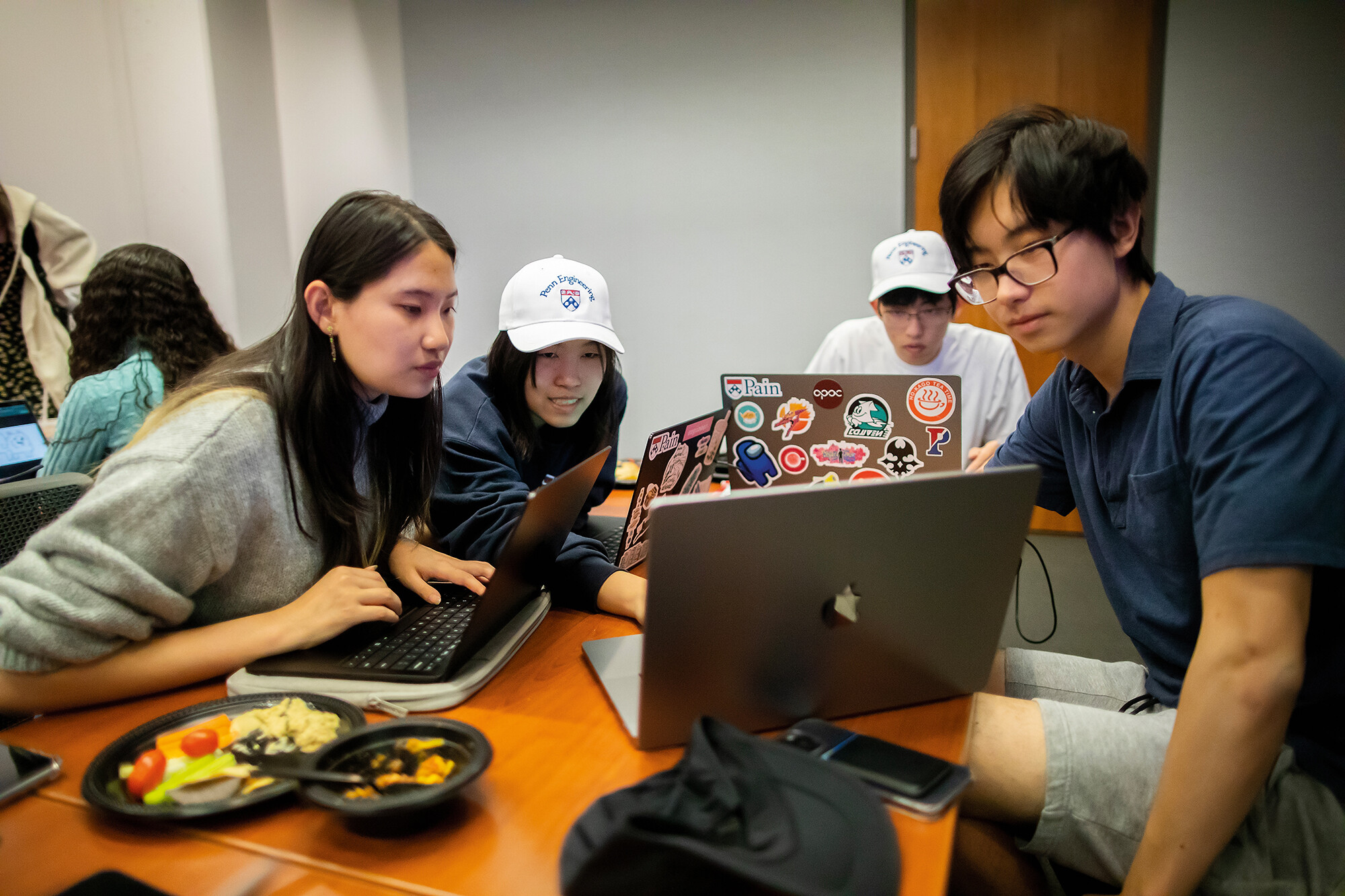
(From left) Doctoral student Hannah Yamagata, research assistant professor Kushol Gupta, and postdoctoral fellow Marshall Padilla holding 3D-printed models of nanoparticles.
(Image: Bella Ciervo)

In today’s ever-expanding world of content and entertainment, video games have taken center stage. From PC to console to mobile gaming, and now to e-sports and competitive gaming, video games are more than hobbyist pastimes—they are a massive industry of dedicated players and professionals who are seeking the next great innovation in gaming and gaming technology.
Students in Penn’s School of Engineering and Applied Science are uniquely equipped to navigate the modern gaming industry as their training in the Digital Media Design (DMD) program prepares them to approach game development with technical rigor and creative insight.
“The way the DMD program at Penn Engineering works is that there is an absolute technical foundation and then you build from there,” says Steven Flisler, a 2006 graduate of the program and vice president of original content and executive producer of Twitch Rivals for Twitch, an interactive livestreaming service for content spanning gaming, entertainment, sports, music, and more. “My experience with DMD taught me how to blend art and science, which has shaped the work I do today to create great entertainment experiences.”
DMD is designed for those interested in computer programming, mathematics, computer graphics, animation, virtual reality and interactive technologies. Graduates from the DMD program have gone on to work for major production studios, including DreamWorks Animation, Pixar, and Disney.
“Great game design is ultimately about systems, so coming to the field with an engineering background is extremely useful,” says Tammy Levy, a 2010 DMD graduate and chief games officer at Captain.tv. “To be successful in this industry, you must like games. You will get burned out very quickly if this is not your passion.”
For DMD students, passion isn’t an issue, and students aren’t waiting until they graduate to join the gaming industry. The student group UPGRADE, the University of Pennsylvania Game Research and Development Environment, has brought together students from the DMD program and beyond to develop games with an emphasis on creative expression and an interdisciplinary approach to game creation. Approximately half of the involved students are DMD majors; other members hail from the College of Arts and Sciences and the Wharton School.
“We have something for English majors to do in a game development club,” shares Faye Zhang, a second-year DMD major and member of UPGRADE ’s social committee who served on the club’s writing and art team during her freshman year.
UPGRADE was founded by 2020 DMD graduate Josh Nadel in 2016. However, after the onset of the COVID -19 pandemic in spring 2020, the club shut down. In fall 2021, two members resurrected the club: Fourth-year DMD major currently studying entrepreneurship and innovation Edward Zhang, and Di Lu, a 2022 DMD graduate currently studying computer graphics and game technology.
“When we came back together in 2021, our goal for the group was not to make the best game, or even a good game, but to make a game,” says Edward Zhang. “Our mission was to make a game within one school year and bring it to market, and we were able to achieve that.”
The game, Bionic Traveler, is a top-down, action RPG game that’s available to play on Steam. UPGRADE members took inspiration from the classic fantasy game The Legend of Zelda, and their game features a battle arena where players can combat enemies, an art museum that displays the original artwork created by UPGRADE ’s art team, and a story log to showcase the narrative work from the writing team.

To build their games within the academic year, UPGRADE follows a hackathon-like structure, where students work in teams to complete miniature projects and then work to bring those mini games together into a collection. In previous years, UPGRADE had focused on creating a single project within distinct disciplinary teams, such as programming, art, or story. However, members found that it was difficult to interface with the different teams and development was slow. Now, having switched to the hackathon-like model for the 2022–2023 academic year, the group has plans to develop multiple games. To accelerate the development process, UPGRADE members use Unity, a free cross-platform game engine. Since its launch in 2005, Unity has been essential in ushering in the current era of accessible game development that makes clubs like UPGRADE possible.
With greater access to game-development technologies outside of the classroom, what compels current students to pursue an engineering degree? Students and alumni report that Penn Engineering’s emphasis on rigorous technical training prepares them to meet expectations in the game industry. While access to coding education and game engines is increasing, excellence in gaming is shifting from sheer programming brawn to a multifaceted ability to bring all sides of a game together.
“You need a deep understanding of the technical side of game development to make big strides, and that is where Penn comes into play,” Levy says. “But it is also about how you can work as a team. You are building something unique and fresh that brings together a variety of perspectives. It takes a lot of soft skills, things they don’t always teach you in a textbook. In the game world, collaboration is crucial.”

Izzy Lopez

(From left) Doctoral student Hannah Yamagata, research assistant professor Kushol Gupta, and postdoctoral fellow Marshall Padilla holding 3D-printed models of nanoparticles.
(Image: Bella Ciervo)

Jin Liu, Penn’s newest economics faculty member, specializes in international trade.
nocred

nocred

nocred